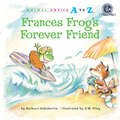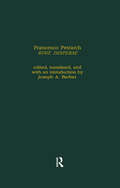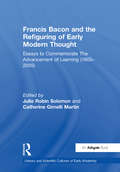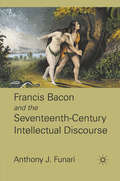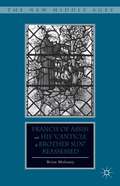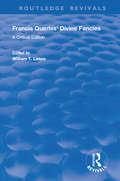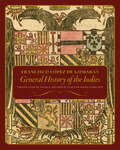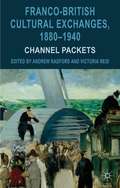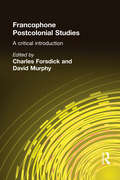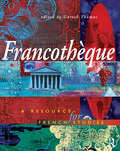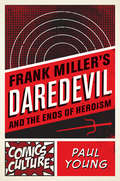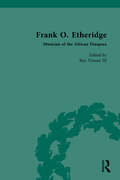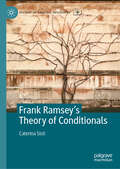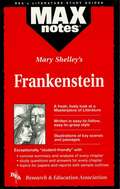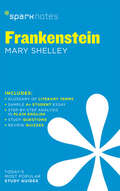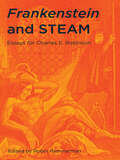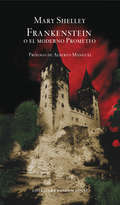- Table View
- List View
Frances Frog's Forever Friend (Animal Antics A to Z)
by Barbara deRubertisFrances Frog is very funny! But sometimes she is a little foolish. Her favorite friend, Felicity Fox, helps Frances learn what it means to be a good friend . . . a forever friend!
Francesco Petrarch Rime Disperse (Library of Medieval Literature #Ser. A)
by Joseph A. BarberFirst published in 1991. It was the lyric poetry of Petrarch that popularized the sonnet in European literature, that set the standard for love poetry for centuries to follow. Compared to the large volume of prose, poetry and notes in Latin, the corpus of Petrarch’s Italian writings is small: the 366 poems that make up the Canzoniere, the 2000 or so verses of the Trionfi, and an undetermined number of poems, drafts and fragments that comprise what we call the Rime disperse. This collection includes indexes of first lines in both Italian and English.
Francis Bacon and the Refiguring of Early Modern Thought: Essays to Commemorate The Advancement of Learning (1605–2005) (Literary and Scientific Cultures of Early Modernity)
by Catherine Gimelli MartinCommemorating the 400th anniversary of the publication of Francis Bacon's Advancement of Learning (1605), this collection examines Bacon's recasting of proto-scientific philosophies and practices into early modern discourses of knowledge. Like Bacon, all of the contributors to this volume confront an essential question: how to integrate intellectual traditions with emergent knowledges to forge new intellectual futures. The volume's main theme is Bacon's core interest in identifying and conceptualizing coherent intellectual disciplines, including the central question of whether Bacon succeeded in creating unified discourses about learning. Bacon's interests in natural philosophy, politics, ethics, law, medicine, religion, neoplatonic magic, technology and humanistic learning are here mirrored in the contributors' varied intellectual backgrounds and diverse approaches to Bacon's thought.
Francis Bacon and the Seventeenth-Century Intellectual Discourse
by Anthony J. FunariThis book explores the resistance of three English poets to Francis Bacon's project to restore humanity to Adamic mastery over nature, moving beyond a discussion of the tension between Bacon and these poetic voices to suggest theywere also debating the narrative of humanity's intellectual path.
Francis Bacon’s Contribution to Shakespeare: A New Attribution Method (Routledge Studies in Shakespeare)
by Barry R. ClarkeFrancis Bacon's Contribution to Shakespeare advocates a paradigm shift away from a single-author theory of the Shakespeare work towards a many-hands theory. Here, the middle ground is adopted between competing so-called Stratfordian and alternative single-author conspiracy theories. In the process, arguments are advanced as to why Shakespeare’s First Folio (1623) presents as an unreliable document for attribution, and why contemporary opinion characterised Shakspere [his baptised name] as an opportunist businessman who acquired the work of others. Current methods of authorship attribution are critiqued, and an entirely new Rare Collocation Profiling (RCP) method is introduced which, unlike current stylometric methods, is capable of detecting multiple contributors to a text. Using the Early English Books Online database, rare phrases and collocations in a target text are identified together with the authors who used them. This allows a DNA-type profile to be constructed for the possible contributors to a text that also takes into account direction of influence. The method brings powerful new evidence to bear on crucial questions such as the author of the Groats-worth of Witte (1592) letter, the identifiable hands in 3 Henry VI, the extent of Francis Bacon’s contribution to Twelfth Night and The Tempest, and the scheduling of Love’s Labour’s Lost at the 1594–5 Gray’s Inn Christmas revels for which Bacon wrote entertainments. The treatise also provides detailed analyses of the nature of the complaint against Shakspere in the Groats-worth letter, the identity of the players who performed The Comedy of Errors at Gray’s Inn in 1594, and the reasons why Shakspere could not have had access to Virginia colony information that appears in The Tempest. With a Foreword by Sir Mark Rylance, this meticulously researched and penetrating study is a thought-provoking read for the inquisitive student in Shakespeare Studies.
Francis Of Assisi And His "canticle Of Brother Sun" Reassessed
by Brian MoloneyBringing the skills of a literary historian to the subject, Brian Moloney considers the genesis of Saint Francis of Assisi's Canticle of Brother Sun to show how it works as a carefully composed work of art. The study examines the saint's life and times, the structure of the poem, the features of its style, and the range of its possible meanings.
Francis Quarles' Divine Fancies: A Critical Edition (Routledge Revivals)
by William T. ListonPublished in 1992, this volume is a critical edition of Francis Quarles' Divine Fancies, including a textual introduction, textual notes and chaptres on press-variants in Q1 and historical collation.
Francisco López de Gómara's General History of the Indies
by Clayton Miles Lehmann Angela HelmerThis work is the first English translation of the entire text of part one of sixteenth-century Spanish historian Francisco López de Gómara’s General History of the Indies. Including substantial critical annotations and providing access to various readings and passages added to or removed from the successive editions of the 1550s, this translation expands the archive of texts available to English speakers reconsidering the various aspects of the European invasion of America. General History of the Indies was the first universal history of the recent discoveries and conquests of the New World made available to the Old World audience. At publication it consisted of two parts: the first a general history of the European discovery, conquest, and settlement of the Americas, and the second a detailed description of Cortés’s conquest of Mexico. Part one—in the multiple Spanish editions and translations into Italian and French published at the time—was the most comprehensive, popular, and accessible account of the natural history and geography of the Americas, the ethnology of the peoples of the New World, and the history of the Spanish conquest, including the most recent developments in Peru. Despite its original and continued importance, however, it had never been translated into English. Gómara’s history communicates Europeans’ general understanding of the New World throughout the middle and later sixteenth century. A lively, comparatively brief description of Europe’s expansion into the Americas with significant importance to today’s understanding of the early modern worldview, Francisco López de Gómara’s General History of the Indies will be of great interest to students of and specialists in Latin American history, Latin American literature, anthropology, and cultural studies, as well as specialists in Spanish American intellectual history and colonial Latin America.
Franco-British Cultural Exchanges, 1880–1940
by Andrew RadfordThis edited collection focuses on the literary connotations of the 'Channel Packet' and how it throws into sharp relief broader issues in French, British, European and even global culture. Using the bi-focal perspective of English and French textual scholarship and cultural studies, as well as recent developments in 'geo-criticism', this project prioritizes dialogues between the literary milieus of France and Britain. Such interaction of, and exposure to, different traditions, regions and peoples erodes hidebound ideas of fixed borders. At the heart of this essay collection is a flexible understanding of 'translation', which covers the transfer of cultural experiences; cross-boundary communication and miscommunication; the articulation of threshold perceptions; multiculturalism; the translation of the stratified past into the modern moment; the transit of one media to another or one discipline to another.
Francophone Postcolonial Studies: A critical introduction (Francophone Postcolonial Studies #1)
by David Murphy Charles ForsdickThis landmark text constitutes the first comprehensive overview of Francophone Postcolonial Studies. Moving away from reductive geographical or linguistic surveys of the Francophone world, this collection of original essays provides a thematic discussion of the complex historical, political and cultural links between France and its former colonies. Providing a theoretical framework for postcolonial criticism of the field, it also aims to trigger a genuine dialogue between Francophone and Anglophone scholars of postcolonialism.Part I provides a historical overview, from the eighteenth to the twentieth century, addressing issues of colonialism, slavery and exoticism. Part II looks at language issues and discusses France's belief in the universality of its language and culture and the postcolonial challenges to that view. Part III discusses issues of diversity and multiculturalism in contemporary Francophone cultures. Part IV concludes with an analysis of the French-language contribution to postcolonialism as well as an examination of Francophone postcolonial thought and culture in the principal areas of the French-speaking world.Edited by two of the up-and-coming names in Francophone Postcolonial Studies, the collection includes contributions from an international team including some of the world's leading scholars in the field.
Francotheque: A resource for French studies
by Open University Open University"Francotheque" seeks to provide a French-language resource for undergraduate students of French. Direct access to contemporary French culture and society is offered through carefully selected authentic texts and a comprehensive overview of France and the French is provided under six broad headings - history, multicultural society, media, the arts, science and technology, the Francophone world - through press articles, historical documents, photographs, posters, advertisements, statistics, poems and songs. Each section starts with an introduction. The authentic texts are accompanied by vocabulary notes, and where appropriate, explanations filling in cultural background. One of the features of the book is the "sujets de reflexion", which provide pre-reading stimulus, thus suggesting a particular context of focus from which to approach many of the contexts.
Frank Ankersmit's Lost Historical Cause: A Journey from Language to Experience (Routledge Approaches to History)
by Peter IckeThe contemporary Dutch historical theorist/philosopher Frank Ankersmit, an erstwhile advocate and promulgator of what has become known as "the linguistic turn" in historical theory, is very well known within the discipline. His early position with regard to the historical text is frequently discussed and evaluated today, and his writings on the subject are often cited. However, this former narrativist position, so robustly and effectively defended by Ankersmit in the past, has been progressively marginalized by Ankersmit himself as his current and radically different theoretical position, most fully expressed in his recent publication Sublime Historical Experience, now (for him) takes precedence. Yet, despite this radical shift in Ankersmit's position, this conspicuous "conversion" of an eminent prime mover in the field of mainstream language centred historical theory, there has been no comprehensive and sustained (investigative) critique of his various works taken in the whole. Consequently, there has until now been no close reading and analytical dissection of that whole, such that Ankersmit's overall trajectory of philosophical thought might be adequately discerned, and perhaps even explained. In short, there is a vacant space here, and the function of this book is, precisely, to fill that space.
Frank Herbert's "Dune": A Critical Companion (Palgrave Science Fiction and Fantasy: A New Canon)
by Kara KennedyThis book offers a critical study of Frank Herbert’s Dune (1965), the world’s bestselling science fiction novel. Kara Kennedy discusses the novel’s exploration of politics and religion, its influential ecological messages, the focus on the human mind and consciousness, the complex nature of the archetypal hero, and the depiction of women’s influence and control. In Dune, Herbert demonstrated that sophistication, complexity, and a multi-layered world with three-dimensional characters could sit comfortably within the science fiction genre. Underneath its deceptively simple storyline sits a wealth of historical and philosophical contexts and influences that make it a rich masterpiece open to multiple interpretations. Kennedy’s study shows the continuing relevance of the novel in the 21st century due to its classic themes and its concerns about the future of humanity, as well as the ongoing nature of issues such as ecological disruption and conflicts over resources and religion.
Frank Lloyd Wright and Ralph Waldo Emerson: Transforming the American Mind
by Ayad RahmaniFrank Lloyd Wright and Ralph Waldo Emerson: Transforming the American Mind is an interdisciplinary volume of literary and cultural scholarship that examines the link between two pivotal intellectual and artistic figures. It probes the degree to which the transcendentalist author influenced the architect’s campaign against dominant strains of American thought. Inspired by Emerson’s writings on the need to align exterior expression with interior self, Wright believed that architecture was not first and foremost a matter of accommodating spatial needs, but a tool to restore intellectual and artistic freedom, too often lost in the process of modernization.Ayad Rahmani shows that Emerson’s writings provide an avenue for interpreting Wright’s complex approach to country and architecture. The two thinkers cohered around a common concern for a nation derailed by nefarious forces that jeopardized the country’s original promise. In Emerson’s condemnations of slavery and inequality, Wright found inspiration for seeking redress against the humiliations suffered by the modern worker, be it at the hands of an industrial manager or an office boss. His designs sought to challenge dehumanizing labor practices and open minds to the beauty and science of agriculture and the natural world. Emerson’s example helped Wright develop architecture that aimed less at accommodating a culture of clients and more at raising national historical awareness while also arguing for humane and equitable policies.Frank Lloyd Wright and Ralph Waldo Emerson presents a new approach to two vital thinkers whose impact on American society remains relevant to this day.
Frank Miller's Daredevil and the Ends of Heroism
by Paul YoungIn the late 1970s and early 1980s, writer-artist Frank Miller turned Daredevil from a tepid-selling comic into an industry-wide success story, doubling its sales within three years. Lawyer by day and costumed vigilante by night, the character of Daredevil was the perfect vehicle for the explorations of heroic ideals and violence that would come to define Miller's work. Frank Miller's Daredevil and the Ends of Heroism is both a rigorous study of Miller's artistic influences and innovations and a reflection on how his visionary work on Daredevil impacted generations of comics publishers, creators, and fans. Paul Young explores the accomplishments of Miller the writer, who fused hardboiled crime stories with superhero comics, while reimagining Kingpin (a classic Spider-Man nemesis), recuperating the half-baked villain Bullseye, and inventing a completely new kind of Daredevil villain in Elektra. Yet, he also offers a vivid appreciation of the indelible panels drawn by Miller the artist, taking a fresh look at his distinctive page layouts and lines. A childhood fan of Miller's Daredevil, Young takes readers on a personal journey as he seeks to reconcile his love for the comic with his distaste for the fascistic overtones of Miller's controversial later work. What he finds will resonate not only with Daredevil fans, but with anyone who has contemplated what it means to be a hero in a heartless world. Other titles in the Comics Culture series include Twelve-Cent Archie, Wonder Woman: Bondage and Feminism in the Marston/Peter Comics, 1941-1948, and Considering Watchmen: Poetics, Property, Politics.
Frank O. Etheridge: Musician of the African Diaspora
by Ben VinsonThis is a book by and about Frank O. Etheridge, an African-American musician from an age of cultural explosion. The decade after World War II saw the coming-of-age of marginalized cultures, and in North America a new voice emerged among peoples of African descent. Etheridge performed in a period when some of the greatest cultural producers of the African-American heritage assumed center-stage. From Shanghai to Singapore; from India to Africa and beyond, Frank Etheridge left us a detailed record of his travels in his unpublished manuscript. The book contains his views, insights, and international itinerary during the 1920s. His book is an important volume in the annals of African-American history, not just for its content, but for what it means and symbolizes. Its readers will journey with him, see through his eyes, understand race and racial prejudice as lived in ordinary skin, and sample culture. Some of Etheridge’s reflections and personal biases will seem like unpleasant contradictions from the way we think about racial prejudice today. However, these jarring moments of dissonance are rich learning opportunities that will connect us to his times, while unraveling a greater understanding of ourselves in our current moment. This manuscript, published for the first time, will be accompanied by editorial commentary written by Professor Ben Vinson III, and will be of great interest to students and scholars of African American history.
Frank Ramsey's Theory of Conditionals (History of Analytic Philosophy)
by Caterina SistiThis book provides the first fully developed account of Frank Ramsey's theory of conditionals. It is divided into two parts. The first part of the book is historical, investigating Ramsey’s texts to discover his views on conditionals. The second part systematically develops a unified account of conditionals, building on Ramsey’s ideas.
Frank Witzel: Perspektiven auf Autor und Werk (Kontemporär. Schriften zur deutschsprachigen Gegenwartsliteratur #4)
by Anke Detken Gerhard KaiserSeit Frank Witzel 2015 den Deutschen Buchpreis für sein bisheriges opus magnum Die Erfindung der Roten Armee Fraktion durch einen manisch-depressiven Teenager im Sommer 1969 erhielt, rückt der 1955 geborene Autor, Zeichner und Musiker nachdrücklich in den Fokus der literaturkritischen Öffentlichkeit. Der vorliegende Band liefert die erste literaturwissenschaftliche Auseinandersetzung mit Witzels Werk, die alle bisherigen Werkphasen berücksichtigt. Dargestellt und analysiert werden Poetologie, Erzähl- und Vertextungsverfahren des Autors und sein seit dem Ende der 1970er Jahre entstandenes Werk aus Gedichten, Essays, Gesprächen, Romanen und Hörspielen. Der Band wird von einem Essay des Autors eingeleitet und enthält außerdem ein mit ihm geführtes Werkstattgespräch sowie eine aktuelle Gesamtbibliographie.
Frankenstein (MAXNotes Literature Guides)
by Kevin KellyREA's MAXnotes for Mary Shelley's Frankenstein MAXnotes offer a fresh look at masterpieces of literature, presented in a lively and interesting fashion. Written by literary experts who currently teach the subject, MAXnotes will enhance your understanding and enjoyment of the work. MAXnotes are designed to stimulate independent thought about the literary work by raising various issues and thought-provoking ideas and questions. MAXnotes cover the essentials of what one should know about each work, including an overall summary, character lists, an explanation and discussion of the plot, the work's historical context, illustrations to convey the mood of the work, and a biography of the author. Each chapter is individually summarized and analyzed, and has study questions and answers.
Frankenstein (Norton Critical Editions #0)
by Mary Shelley“Because I’m teaching an intro-level course in comparative literature, this edition was extremely helpful in showing the variety of critical approaches that they can take toward a single text. The article on radical science also helped me compare Frankenstein to Alasdair Gray’s Poor Things. I highly recommend this edition of Frankenstein and will use it in the future.” Joshua Beall, Rutgers University This Norton Critical Edition includes: The 1818 first edition text of the novel, introduced and annotated by J. Paul Hunter. Three maps and eight illustrations. A wealth of source and contextual materials, thematically arranged to promote classroom discussion. Topics include “Sources, Influences, Analogues,” “Circumstances, Composition, Revision,” and “Reception, Impact, Adaptation.” Eleven critical essays on Frankenstein’s major themes, six of them new to the Third Edition. A chronology and a selected bibliography. About the Series Read by more than 12 million students over fifty-five years, Norton Critical Editions set the standard for apparatus that is right for undergraduate readers. The three-part format—annotated text, contexts, and criticism—helps students to better understand, analyze, and appreciate the literature, while opening a wide range of teaching possibilities for instructors. Whether in print or in digital format, Norton Critical Editions provide all the resources students need. “A wonderful critical edition?I’m impressed with the quality of the essays. I will use this book in my Brit Lit II survey course.” ?Mary Thompson, University of Sussex (United Kingdom) “This is a magnificent edition of Frankenstein! The articles selected are really relevant. . . . The notes are also significant and informative, and the materials are equally interesting. Very good indeed!” ?Dr. Antonio Gonzales, Filologia Moderna, University of Castilla–La Mancha (Spain)
Frankenstein 2nd Edition
by Mary Shelley Johanna M. SmithThis revision of a widely adopted critical edition presents the 1831 text of Mary Shelley's English Romantic novel along with critical essays that introduce students to Frankenstein from contemporary psychoanalytic, Marxist, feminist, gender, and cultural studies perspectives. An additional essay demonstrates how various critical perspectives can be combined. In the second edition, 3 of the 6 essays are new. The text and essays are complemented by contextual documents, introductions (with bibliographies), and a glossary of critical and theoretical terms.
Frankenstein Abridged: A Translation in Plain & Modern English
by Mary Shelley Brock ParksReducing the original text by almost forty pages, this abridged version of Frankenstein also updates the language of the original novel for modern readers. Sentence by sentence, we have replaced outdated vocabulary and convoluted paragraphs in a way that is true to the original text but easier to follow. This version also provides careful edits of overly long and redundant scenes so that the main story moves along at a faster pace.
Frankenstein SparkNotes Literature Guide (SparkNotes Literature Guide Series #27)
by Mary Shelley SparkNotesFrankenstein SparkNotes Literature Guide by Mary Wollstonecraft Shelley Making the reading experience fun! When a paper is due, and dreaded exams loom, here's the lit-crit help students need to succeed! SparkNotes Literature Guides make studying smarter, better, and faster. They provide chapter-by-chapter analysis; explanations of key themes, motifs, and symbols; a review quiz; and essay topics. Lively and accessible, SparkNotes is perfect for late-night studying and paper writing. Includes:An A+ Essay—an actual literary essay written about the Spark-ed book—to show students how a paper should be written.16 pages devoted to writing a literary essay including: a glossary of literary termsStep-by-step tutoring on how to write a literary essayA feature on how not to plagiarize
Frankenstein and STEAM: Essays for Charles E. Robinson
by Brian Bates Susan J. Wolfson Mark A. McCutcheon Lisa Crafton Siobhan Watters Lisbeth Chapin L. Adam Mekler Robin HammermanCharles E. Robinson, Professor Emeritus of English at The University of Delaware, definitively transformed study of the novel Frankenstein with his foundational volume The Frankenstein Notebooks and, in nineteenth century studies more broadly, brought heightened attention to the nuances of writing and editing. Frankenstein and STEAM consolidates the generative legacy of his later work on the novel's broad relation to topics in science, technology, engineering, arts, and mathematics (STEAM). Seven chapters written by leading and emerging scholars pay homage to Robinson's later perspectives of the novel and a concluding postscript contains remembrances by his colleagues and students. This volume not only makes explicit the question of what it means to be human, a question Robinson invited students and colleagues to examine throughout his career, but it also illustrates the depth of the field and diversity of those who have been inspired by Robinson's work. Frankenstein and STEAM offers direction for continuing scholarship on the intersections of literature, science, and technology. Published by the University of Delaware Press. Distributed worldwide by Rutgers University Press.
Frankenstein o El moderno Prometeo
by Mary ShelleyEn el verano de 1816, el poeta Percy B. Shelley y su esposa Mary se reunieron con Lord Byron y su médico Polidori en una villa a orillas del lago Leman. A instancias de Lord Byron y para animar una velada tormentosa, decidieron que cada uno inventaría una historia de fantasmas. La más callada y reservada, Mary Shelley, dio vida así a quien sería su personaje más famoso: el doctor Frankenstein. Al cabo de un año completaría la novela, hoy día un clásico imperecedero de la literatura gótica. La historia es de todos conocida: un científico decide crear una criatura con vida propia a la que luego rechaza. Metáfora sobre la vida, la libertad y el amor, Frankenstein o el moderno Prometeo es una maravillosa fábula con todos los ingredientes de los grandes mitos, un gran clásico que ahora recuperamos con una nueva traducción y precedido de un espléndido estudio de Alberto Manguel sobre la influencia del mito en el imaginario del cine.
